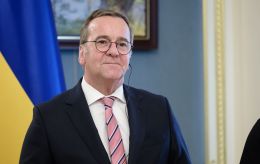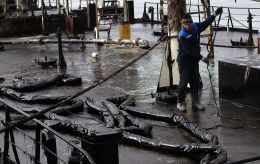Energy truce between Ukraine and Russia: Is it really holding?
 Destroyed Ukrainian thermal power plant (photo: Getty Images)
Destroyed Ukrainian thermal power plant (photo: Getty Images)
With US mediation, Ukraine and Russia agreed to halt strikes on energy and port infrastructure. But just days later, Russia cast doubt on the deal.
RBC-Ukraine examines the key question: is the limited truce still holding — or already broken?
Contents:
What happened to the energy truce?
The agreements between Ukraine, the US, and Russia meant that the parties would refrain from striking energy facilities for a set period.
Following negotiations in Saudi Arabia, the White House issued two statements. The first concerned the results of the meeting between US and Russian expert groups. According to the statement, the US and Russia agreed to "develop measures" to implement the agreement between Trump and Putin on banning strikes on energy facilities in Russia and Ukraine.
A similar provision was included in the second statement — following the meeting between the Ukrainian and US teams. "The US and Ukraine agreed to develop measures to implement the agreement between President Trump and President Zelenskyy on banning strikes on energy facilities in Russia and Ukraine," the statement reads.
The US and Russia statement also included a section noting that the US would help restore Russia's access to the global agricultural product and fertilizer export market. This was related to another type of truce — at sea. Subsequently, Russia presented a list of demands under which it allegedly would agree not to engage in conflict in the Black Sea, primarily the lifting of several sanctions. Overall, the situation with the maritime truce seems to be at a pause for now, as sanctions in this case must be lifted by Europe, and there is little enthusiasm for this. Additionally, the idea of a maritime truce itself holds little substance, as large-scale combat operations have not been taking place in the Black Sea for some time now.
As for energy, the scale of Russian attacks between March 18 and 26 (following the Trump-Putin conversation) indeed decreased. Strikes on individual facilities continued during this period, but not in such large waves as in December or January. Following the negotiations in Riyadh, Ukraine also refrained from striking Russian energy infrastructure, although the aggressors continually tried to accuse Ukraine of doing so.
This situation persisted until March 27, when Russia launched a powerful strike on Kherson. On the night of March 28, the aggressor country attacked oil and gas industry facilities in Poltava. At that time, Zelenskyy stated that the strike on Kherson was a clear violation of the energy truce.
Moscow, on the other hand, continues to accuse Ukraine of strikes on Russian energy infrastructure. In particular, Russia's Ministry of Defense claimed that Ukrainian forces attacked a gas measurement station in Sudzha.
At a briefing on March 28, Zelenskyy reported that a monitoring mechanism for the adherence to the energy truce had not yet been developed. The US was supposed to work on this with the participation of third countries. According to him, violations of the agreements should be responded to by the US. Zelenskyy instructed Defense Minister Rustem Umierov to provide Washington with all necessary evidence.
"Until there are third countries responsible for monitoring, the United States of America is our contact. I asked Umierov to gather all the information from the State Emergency Service, the Ministry of Internal Affairs, the energy sector, our air defense, and everyone else — he will pass it on to the American side," Zelenskyy stated.
However, there is no clear answer to the key question: after the Russian strikes, does Ukraine consider itself free from obligations not to strike Russian energy facilities and to adhere to the ceasefire. Given the appeals to the US, it seems that Ukraine does not plan to engage in a new round of powerful strikes on energy infrastructure for now.
Moreover, Ukraine and Russia have differing positions on the start and end dates of the energy truce. Russia believes it began on March 18 — the day of the Trump-Putin conversation. Ukraine insists that the ceasefire started on March 25, when technical negotiations in Saudi Arabia were concluded.
Why Russia struck energy infrastructure?
Russia currently has no need for any peace processes because the Kremlin believes it has both the time and the opportunity to improve its position, said political scientist and president of the Analytical Center "Politica" Oleh Lisnyi in an interview with RBC-Ukraine.
"Whether this is true or not, time will tell, but they (the Russians - ed.) are confident in it. This is evidenced by Putin's rhetoric, as he increasingly appears in military uniforms. He never wore them before, but now he has been seen in one in Kursk and, supposedly, on a submarine, where he talks about the illegitimacy of Ukraine's government. This is all about stalling," Lisnyi said.
According to him, the contacts that took place in Saudi Arabia and through phone calls are still consultations before large negotiations. However, in the near future, such negotiations are unlikely, as there is no real constructiveness from Russia. US Secretary of State Marco Rubio also acknowledged that it is too early for a meeting at a high political level.

Workers at the destroyed thermal power plant (photo: Getty Images)
"Russia is using an old method: they don’t say no, but they also don’t say yes, or they demonstrate some 'half-position' which they then destroy, only to present new conditions, and so on until they achieve their desired outcome. Right now, they don’t want peace; they want to fool Trump into weakening sanctions," Lisnyi noted in an interview with the publication.
In this situation, the US should not expect decisive actions, said political scientist and PhD in philosophy Andrii Horodnytskyi to the RBC-Ukraine YouTube channel.
"Until there is a ceasefire, Trump will be like a snake on a frying pan, jumping around and saying: 'Let’s push to the end, let’s endure a little longer.' Because they are hitting Ukraine, not the United States. And that makes them comfortable. So, the Russians are taking advantage of this," said Horodnytskyi.
At the same time, in the expert's opinion, Trump is starting to realize that Russia is manipulating him. "I think Trump himself no longer believes in this (reaching a ceasefire by the 100th day of his presidency – ed.). With each round of negotiations, he sees that he is being led by the nose. He is finally starting to see the truth and understands that the issue here is not Ukraine," he emphasized.
Therefore, the US needs to at least develop a "Plan B." If Trump’s diplomatic efforts fail, it will mean the end of the US as a global hegemon.
Truce agreement – how it happened
The ceasefire was preceded by several rounds of negotiations in Saudi Arabia and phone conversations between the heads of state. In mid-March, Ukrainian and American teams met in Jeddah, where Ukraine supported the US proposal for a full 30-day ceasefire. However, Russia raised a number of reservations. Following this, US President Donald Trump had discussions with Vladimir Putin and Volodymyr Zelenskyy. Ultimately, the parties reached only a limited ceasefire, focusing on energy and maritime issues.
Details were finalized on a technical level between March 23 and 25 in Riyadh. The Ukrainian and Russian delegations did not meet directly. They were in separate rooms, with the US acting as a mediator between them.
Additionally, Russia did not want to discuss halting attacks on civilian infrastructure during the talks in Riyadh, according to Deputy Head of the President’s Office of Ukraine Ihor Zhovkva. He stated that the Russian delegation claimed they did not have the relevant mandate.
At the same time, Ukrainian Ministry of Foreign Affairs spokesperson Heorhii Tykhyi announced on March 27 that new rounds of negotiations involving Ukraine, the US, and Russia are expected. However, specific dates are not yet known. It is likely that the US is still working on a strategy for further negotiations. Meanwhile, the situation with the energy ceasefire remains up in the air.
Sources: official statements from the White House, remarks from President of Ukraine Volodymyr Zelenskyy, and comments by political scientists Oleh Lisnyi and Andrii Horodnytskyi.

